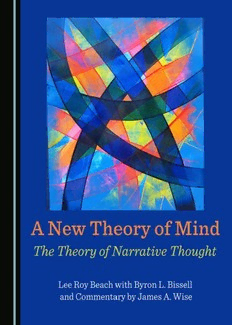
A New Theory of Mind: The Theory of Narrative Thought PDF
Preview A New Theory of Mind: The Theory of Narrative Thought
A New Theory of Mind : The Theory of Narrative Thought A New Theory of Mind : The Theory of Narrative Thought By Lee Roy Beach With Byron L. Bissell Commentary by James A. Wise A New Theory of Mind: The Theory of Narrative Thought By Lee Roy Beach with Byron L. Bissell and Commentary by James A. Wise This book first published 2016 Cambridge Scholars Publishing Lady Stephenson Library, Newcastle upon Tyne, NE6 2PA, UK British Library Cataloguing in Publication Data A catalogue record for this book is available from the British Library Copyright © 2016 by Lee Roy Beach All rights for this book reserved. No part of this book may be reproduced, stored in a retrieval system, or transmitted, in any form or by any means, electronic, mechanical, photocopying, recording or otherwise, without the prior permission of the copyright owner. ISBN (10): 1-4438-8718-8 ISBN (13): 978-1-4438-8718-2 Dedicated to our endlessly patient wives. “A scientist’s job is to tell interesting stories.” —Ward Edwards CONTENTS Preface ........................................................................................................ ix Part I: Fundamentals Chapter One ................................................................................................. 2 Mind Chapter Two .............................................................................................. 14 Cognitive Abilities Part II: Narrative Thought Chapter Three ............................................................................................ 34 Narrative Urge Chapter Four .............................................................................................. 49 Narrative Thought Chapter Five .............................................................................................. 69 Narrator Chapter Six ................................................................................................ 86 Narrative Errors Part III: Narrative and Action Chapter Seven .......................................................................................... 102 Managing the Future Chapter Eight ........................................................................................... 117 Narrative-based Decisions Chapter Nine ............................................................................................ 133 Public Narratives viii Contents Chapter Ten ............................................................................................. 151 Narrative Tyranny Part IV: Mind Revisited Chapter Eleven ........................................................................................ 168 A New Theory of Mind Further Reading ....................................................................................... 181 Authors .................................................................................................... 190 Index ........................................................................................................ 192 PREFACE In a previous book (Beach, 2010), which was a run-up to this one, I introduced the Theory of Narrative Thought and explored its implications for decision making. In this book, my colleagues and I extend the 2010 discussion by advancing three propositions. The first proposition, echoing the 2010 book, is that narrative thinking is the “natural” mode of human thought. The second proposition is that the “urge” to think narratively reflects known neurological processes that format selected neural events in a narrative form, i.e. a rudimentary story. The third proposition is that although narrative thinking is a product of evolution, it enables humans to transcend some of their evolutionary limits, making it possible for them to actively shape the physical environment by anticipating and shaping the events that impact that environment. Underlying these three propositions is the observation that the course of the Human Experiment has been twofold: evolving the ability to meet environmental demands and evolving the ability to modify those demands. The former has shaped our physical characteristics, including our neurology, and the latter has shaped how we use those characteristics to create more supportive, more comfortable environments. These three propositions form the backbone of our attempts to address the task we have set ourselves (indeed, the task facing cognitive science in general), which is to fill the gap between the realm of neural activity and the realm of subjective experience and action. That is, neuroscience provides increasingly better knowledge about how the nervous system works, including how the brain functions. And the outcome of what the nervous system and the brain do is revealed in our own and the everyday lives of those around us—the ways in which we cope with the demands of our environment and the ways in which we shape the environment to our advantage. The task is to bridge the gap. At the moment, the greatest effort to bridge the gap is invested in trying to build from the bottom up, from neurophysiology to experience. And a great deal is being learned. For example, the 2014 Nobel Prize in physiology was awarded for discovery of “place cells” in the entorhinal cortex of the brain and “grid cells” in the hippocampus that together enable the brain to form a map of surrounding space that supports spatial navigation. As valuable as this “building upward” strategy is, however, it
